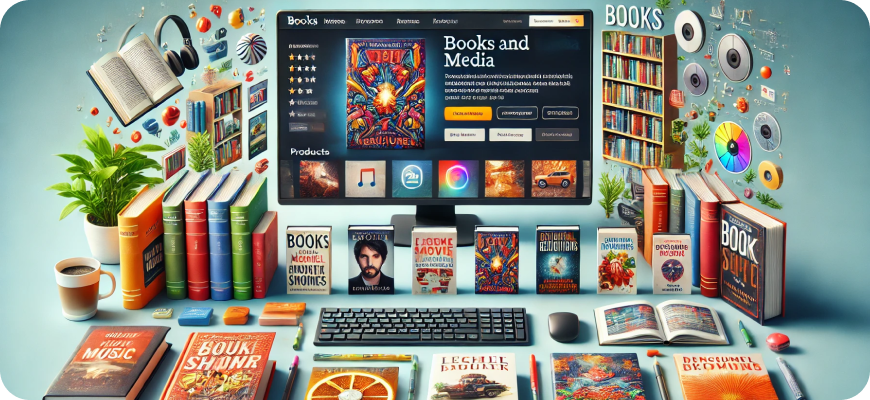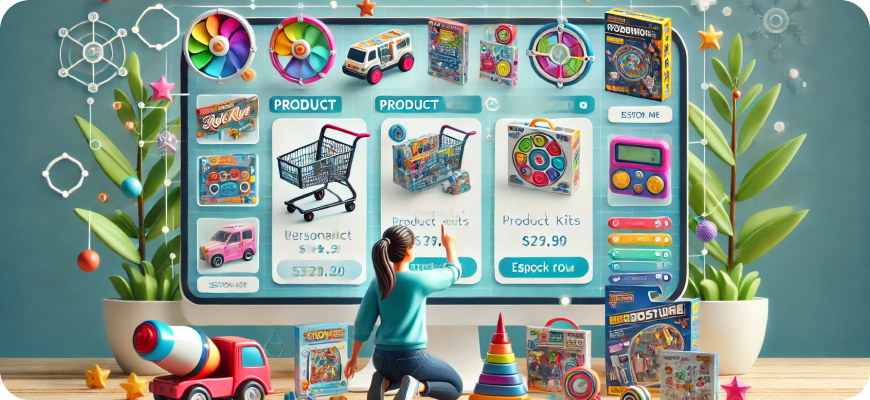Ecommerce Best Practices for Books & Media
The books and media e-commerce industry is a dynamic market that encompasses books, magazines, music, movies, and digital content like audiobooks and eBooks. This sector has evolved significantly with the advent of digital formats and the convenience of online shopping, presenting both opportunities and challenges for sellers. To thrive, e-commerce businesses must focus on creating personalized experiences, offering comprehensive content, and building community engagement. By following best practices, you can attract readers, listeners, and viewers, enhance their shopping experience, and build loyalty.
Here is a comprehensive guide to e-commerce best practices for books and media businesses.

1. Provide Comprehensive Product Descriptions and Metadata
Detailed product information helps customers make informed decisions:
- Book Synopses and Previews: Offer detailed synopses of books, with an option to read a preview chapter or sample pages. For media like movies or music albums, include trailers, track lists, or sample tracks.
- Author or Creator Bios: Provide background information about authors, filmmakers, or artists to give context and connect customers with the creators.
- Product Metadata: Include comprehensive metadata such as publication date, genre, language, ISBN, runtime (for movies or audiobooks), and file format (for digital media).
2. Leverage Personalization and AI Recommendations
Books and media e-commerce thrive on personalization:
- AI-Driven Recommendations: Use AI to analyze customer behavior, preferences, and past purchases to suggest similar books, movies, or music albums.
- Curated Lists: Create curated collections based on genres, themes, bestsellers, or staff picks. For example, “Top Thrillers of the Year” or “Books for History Buffs.”
- Personalized Emails: Send personalized marketing emails based on browsing history and past purchases, recommending new releases, related titles, or exclusive offers.
3. Optimize for Mobile Shopping
Mobile optimization is essential as many customers browse and shop for books and media on their smartphones:
- Responsive Design: Ensure your website is fully optimized for mobile devices with intuitive navigation, fast loading times, and a seamless user interface.
- Mobile Checkout Optimization: Simplify the checkout process with mobile-friendly forms, auto-fill options, and support for digital wallets like Apple Pay and Google Pay.
- Mobile Apps: Consider creating a mobile app to offer personalized experiences, in-app purchases, and exclusive content, such as app-only discounts or reading challenges.
4. Offer Digital Formats and Subscriptions
Digital content is a growing segment of the books and media market:
- eBooks and Audiobooks: Offer digital versions of books to cater to readers who prefer eBooks or audiobooks. Ensure compatibility with popular devices such as Kindle, tablets, and smartphones.
- Subscription Models: Provide subscription services for unlimited access to digital content, such as book clubs, streaming services, or audiobook subscriptions.
- Download and Streaming Options: Offer flexible options for customers to download or stream content, providing convenience for on-the-go consumption.
5. Use High-Quality Visuals and Interactive Content
Visual content plays a key role in the online shopping experience for books and media:
- High-Resolution Cover Art: Display high-quality cover art for books, albums, or movies, ensuring the images are eye-catching and accurately represent the product.
- Videos and Trailers: Include video trailers for movies, music videos for albums, or promotional interviews with authors.
- Interactive Previews: Allow users to browse sample chapters, listen to sample audio tracks, or watch a short clip from a movie or series.
6. Highlight Customer Reviews and Ratings
Social proof is a powerful tool for influencing purchasing decisions:
- Verified Reviews: Encourage customers to leave verified reviews and ratings for books and media they have purchased. Display both positive and negative reviews for transparency.
- Reviewer Profiles: Showcase profiles of top reviewers or offer incentives for detailed, thoughtful reviews.
- Review Sorting Options: Allow users to sort reviews by relevance, date, rating, or helpfulness to enhance their browsing experience.
7. Create Community Engagement and User-Generated Content
Building a community around your brand fosters loyalty and engagement:
- Discussion Forums and Book Clubs: Create online communities where customers can discuss books, share opinions, and participate in book clubs or media discussion groups.
- User-Generated Content (UGC): Encourage customers to submit their reviews, ratings, photos, or videos showcasing their experiences with your products.
- Social Media Integration: Use social media platforms to host live events, author Q&A sessions, or virtual movie nights.
8. Provide Flexible Payment and Financing Options
Offering flexible payment options makes purchases more accessible:
- Multiple Payment Methods: Accept various payment methods, including credit/debit cards, digital wallets, and bank transfers.
- Buy Now, Pay Later (BNPL) Services: Partner with BNPL providers like Klarna, Afterpay, or Affirm to enable customers to split payments over time, especially for expensive box sets or collections.
- Subscription Payment Models: Offer monthly or annual subscription payments for access to digital libraries, streaming services, or book clubs.
9. Optimize the Checkout Process
A smooth checkout process is essential for reducing cart abandonment:
- Guest Checkout Option: Allow customers to complete purchases without creating an account.
- Progress Indicators: Show progress bars during checkout to reassure customers and reduce drop-off rates.
- Auto-Fill and Security Features: Use auto-fill for payment and shipping information and implement strong security measures to protect customer data.
10. Focus on Content Marketing and SEO
Content marketing can help engage readers, establish authority, and drive organic traffic:
- Blogs and Articles: Create content around books, movies, or music, such as author interviews, book reviews, industry news, or themed reading lists.
- SEO Optimization: Optimize product pages and blog posts for relevant keywords like “Best Romance Novels 2024,” “Top Audiobooks for Road Trips,” or “Latest Indie Movies.”
- Voice Search Optimization: Adapt your content for voice search by targeting conversational keywords and queries.
11. Provide Excellent Customer Support
Responsive and knowledgeable customer support can make a lasting impression:
- Live Chat and Chatbots: Offer instant support through live chat for inquiries about book availability, subscription services, or order issues.
- Comprehensive FAQ Section: Maintain a detailed FAQ section addressing common questions about formats, compatibility, returns, and subscriptions.
- Order Follow-Ups: Send follow-up emails after purchases to ensure customer satisfaction, solicit feedback, and offer related product recommendations.
12. Offer Loyalty Programs and Referral Incentives
Loyalty programs and referral incentives encourage repeat business:
- Points-Based Rewards Program: Reward customers for every purchase, review, or referral, with points that can be redeemed for discounts, exclusive content, or free products.
- Exclusive Member Perks: Provide loyalty members with early access to new releases, special discounts, or limited-edition books and media.
- Referral Programs: Offer incentives to customers who refer friends to your store, such as discounts or exclusive merchandise for both the referrer and the new customer.
13. Emphasize Fast and Reliable Shipping
Shipping is an essential part of the customer experience, especially for physical books and media:
- Multiple Shipping Options: Offer a range of shipping options, including expedited delivery for new releases or limited-edition items.
- Real-Time Tracking: Provide customers with real-time order tracking to keep them informed about their shipment status.
- Subscription Delivery Preferences: Allow subscription customers to customize delivery dates and frequency for maximum convenience.
14. Implement Advanced Search and Filtering
A robust search and filtering system makes it easy for customers to find the content they’re looking for:
- Advanced Search Filters: Offer filters based on genre, author, format, publication date, and more.
- Predictive Search Suggestions: Provide predictive text suggestions and autocomplete options to help customers quickly find what they need.
- Category Navigation: Organize content into categories and subcategories that align with customer preferences, such as “Bestselling eBooks” or “New Music Releases.”
15. Highlight Promotions and Seasonal Campaigns
Promotions and seasonal campaigns can drive sales and customer engagement:
- Holiday-Themed Sales: Create promotions around major holidays, like Christmas, Valentine’s Day, or Back-to-School season, offering discounts on relevant products.
- Pre-Order Offers: Provide special deals or exclusive content for customers who pre-order new releases.
- Bundle Deals: Offer bundled products, such as book series collections, music box sets, or themed movie packs, at a discounted price.
16. Ensure Digital Rights Management (DRM) and Copyright Compliance
Digital content requires robust rights management:
- DRM Solutions: Use DRM to protect digital content from unauthorized copying and sharing while maintaining an easy-to-use customer experience.
- Clear Licensing Information: Provide clear licensing terms for digital content, such as the number of devices it can be used on.
- Compliance with Copyright Laws: Ensure all content sold on your platform adheres to copyright laws and industry regulations.
17. Use Data Analytics for Continuous Optimization
Data-driven insights can help you refine and improve your business:
- Customer Behavior Analysis: Use analytics to track customer behavior, including browsing patterns, purchase history, and preferences.
- A/B Testing: Test different product pages, checkout processes, and marketing messages to identify what drives the best results.
- Retention Metrics: Monitor metrics such as repeat purchase rates, customer lifetime value, and churn rates to identify areas for improvement.
18. Highlight Author and Creator Engagement
Connecting customers with creators can enhance engagement and loyalty:
- Author Q&A Sessions: Host virtual or live events where customers can interact with authors, filmmakers, or musicians.
- Signed Editions and Exclusive Content: Offer signed books, exclusive tracks, or behind-the-scenes content to create a sense of exclusivity.
- Creator Spotlights: Feature profiles and interviews with creators on your website, highlighting their work and upcoming projects.
19. Utilize Social Media for Promotion and Engagement
Social media is a powerful platform for engaging with your audience and promoting books and media:
- Shoppable Posts: Use platforms like Instagram and Facebook to create shoppable posts, making it easy for customers to purchase directly from their feeds.
- Interactive Content: Share engaging content such as polls, book club recommendations, and Q&A sessions with authors or creators.
- Collaborations with Influencers: Partner with booktubers, bookstagrammers, or media influencers to review and showcase your products authentically.
20. Focus on Sustainability and Eco-Friendly Practices
Sustainability is an increasing priority for many customers:
- Eco-Friendly Packaging: Use recyclable or biodegradable packaging for physical books and media.
- Carbon-Neutral Shipping: Offer carbon-neutral shipping options and highlight your efforts to reduce your environmental impact.
- Sustainable Practices: Communicate your commitment to sustainable sourcing and eco-friendly production for printed materials.

Conclusion
E-commerce for books and media thrives on personalized experiences, community engagement, and seamless customer support. By providing comprehensive content, offering flexible payment options, and focusing on customer satisfaction, you can build a loyal customer base and stand out in this competitive market. Whether you’re selling physical books, digital content, or media bundles, following these best practices will create an exceptional shopping experience and foster long-term success in the books and media e-commerce industry.
This guide provides actionable strategies for creating memorable customer experiences, building trust, and optimizing your e-commerce business for books and media.






